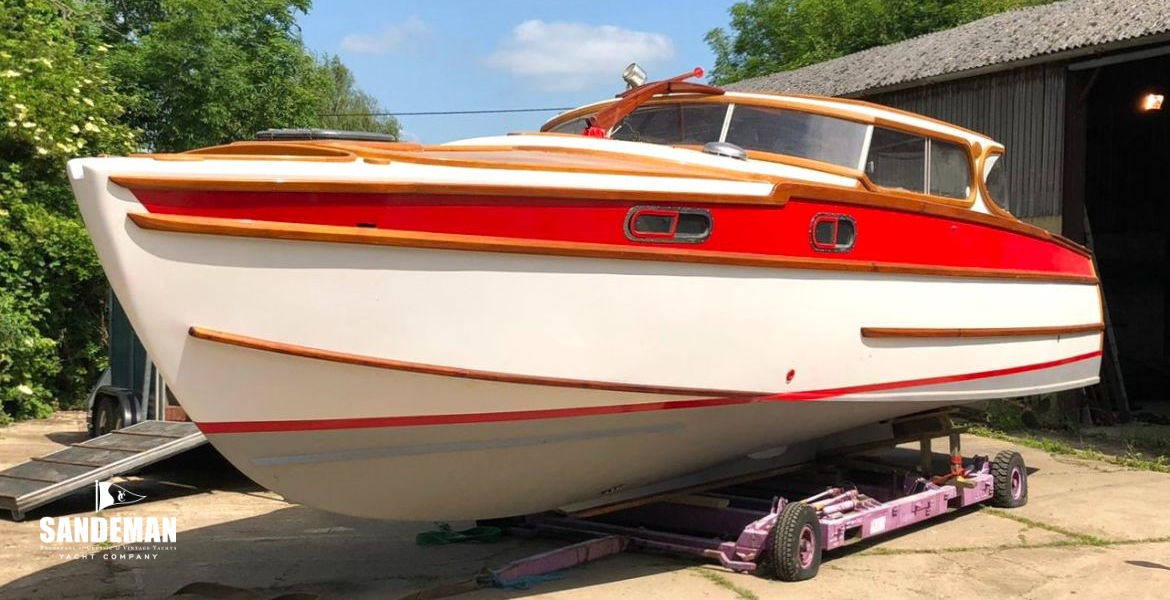
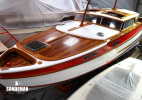
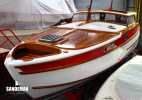
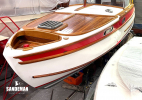

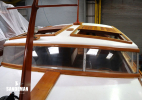
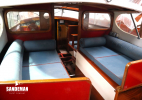
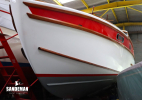
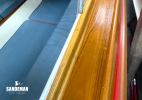


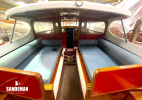

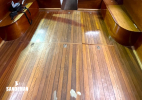
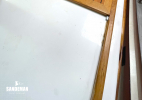
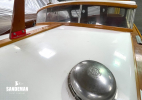
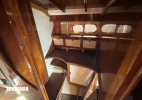
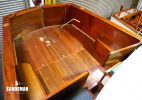

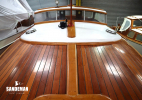
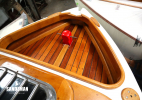
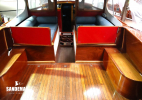
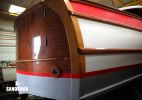
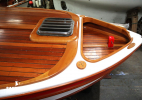
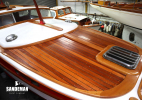
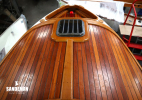
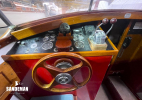

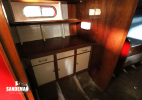
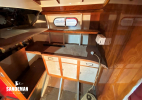
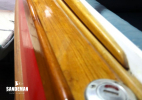
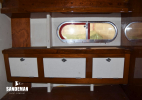
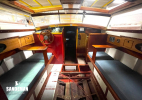
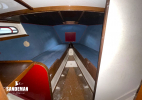
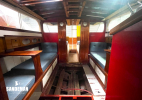
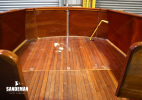
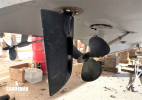
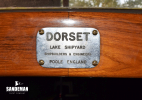

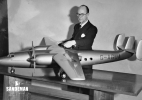
| Designer | Arthur E. Hagg |
|---|---|
| Builder | Dorset Lake Shipyard, Hamworthy, Poole |
| Date | 1963 |
| Length overall | 36 ft 0 in / 10.97 m |
| Length deck | 35 ft 10 in / 10.91 m |
| Length waterline | 35 ft 0 in / 10.67 m |
|---|---|
| Beam | 10 ft 0 in / 3.05 m |
| Draft | 2 ft 11 in / 0.89 m |
| Displacement | 5.5 Tonnes |
| Construction | Marine ply on mahogany and spruce frame |
| Engine | 2 x Parsons Ford Barracuda 6-cylinder 86 hp |
|---|---|
| Location | United Kingdom |
| Price | Sold |
These details are provisional and may be amended
Described by motor yachting journalist Alec McMullen as "one of the most distinctive production motor cruisers ever built", the Hagg 36 represents the culmination of a lifetime spent creating beautiful, innovative, efficient, speedy - and uniquely styled - machines of air and sea by one of the unsung forces in 20th Century aircraft and power boat design, Arthur E. Hagg. AMUCHI MAI is a rare and authentic example of the early batch of smooth riding, semidisplacement wooden Hagg 36s, beautifully built by Dorset Lake Shipyard using techniques developed by the designer in aircraft production. Rescued from the Thames by a skilled woodworker, her restoration became a labour of love sadly not completed through failing health. The structural and external elements of this work have been mostly done, leaving a new owner to undertake the interior refit, renew all systems, including tanks, and most probably repower. The result will be one of the most eye-catching yet practical of classic motor yachts, and proof that Arthur Hagg was way ahead of his time.
Interested in AMUCHI MAI in more detail.
It is believed that the restorer completed:
- hull re-skinning as required above and below waterline
- bilge and underbody epoxy coated
- all exterior trim, paint and varnish - though may need new coats
- restoration of stern gear and replacement of through-hulls
Completion will include:
- re-powering
- at least thorough check of steering system
- all new electrical and electronics
- new tanks and associated systems
- reinstatement of some deck fittings
- interior refit/ refurbishment
- installation of galley and WC compartment equipment
- new upholstery
Arthur Ernest Hagg (1888-1985) may be the finest British power boat designer you've never heard of, yet the products of his bright mind in two quite distinct careers during a very long life were among the best, most innovative, and distinctively styled in their fields.
Hagg trained initially in furniture design, then in 1915 joined the aircraft manufacturer Airco, from 1916 becoming a draughtsman under their chief designer: one Geoffrey de Havilland. Right place, right time, and with a war pushing development apace. When de Havilland formed the de Havilland Aircraft Company in 1920, Hagg followed and worked on the design of the legendary "DH" aircraft, including the Moth (Gipsy Moth, Tiger Moth etc) and Dragon series, eventually becoming Chief Designer.
His 1934 high speed, bright red DH.88 Comet design "Grosvenor House", triumphant in that year's England-Australia MacRobertson Air Race, brought public attention to this otherwise apparently happily unsung force in British aviation - setting a record for that route by a piston engine aircraft that has never been beaten. Perhaps of more interest to Arthur Hagg, however, was the DH.88's cold-moulded 'stressed skin' timber construction involving the use of high-grade spruce and synthetic glues.
Hi-tec composite wood construction methods would be further developed by Hagg and his colleagues in 1936 in his beautiful DH.91 Albatross trans- Atlantic mail plane/ passenger liner design with a plywood balsa sandwich monocoque fuselage – further and famously developed in the iconic Second World War DH.98 Mosquito multi-role combat plane. But it was to be the construction method rather than direct involvement in the Mosquito that would be Hagg’s legacy in the pre-war aircraft industry. He resigned from de Havilland in 1937 - "so that Captain de Havilland can have complete control", the UK press quoted.
Was it a tiff? [Not with de Havilland, we later learned from a wonderful 1985 appreciation by Kevin Desmond, but "due to a policy and personality clash with company chairman Alan Butler"]. Or was it Hagg's passion for the sea and sailing taking over as he approached 50? He'd become the owner of a rather old sailing yacht in 1931, the sixty-year-old Payne of Southampton cutter MERMAID, quickly replaced in 1933 by the W.S. Parker of Oulton Broad-designed 40ft motorsailer MERMAID II. One thing is for sure: by 1937, backed by property developer with a penchant for '30s art deco, Charles H. Kearley, Hagg was in control of his own boatyard, Walton Yacht and Launch Works at Shepperton on the Thames, designing and building - as one might imagine, not using traditional wood boatbuilding methods - innovative and strikingly styled river cruisers, and seagoing motor yachts with a reputation for excellent seakeeping - and winners in the offshore "races" then popular, including London to Cowes.
The outbreak of the Second World War put an end to Hagg’s Walton project, at least in the designing of pleasure boats. The yard was of course kept busy building for the war effort, in particular fast launches and air sea rescue boats, but these builds were mostly designed by others to standard War Office
specifications.
Hagg’s brilliant mind was best employed elsewhere, and in 1943 he joined aircraft manufacturer Airspeed Ltd as Technical Director and Director of Design, initially at Cobham, Surrey, and from 1944 at Christchurch, which was then in Hampshire. Having been brought up in Bournemouth, this must have been like a homecoming. Hagg’s most prominent project with Airspeed was the beautiful Ambassador airliner, a development of his pre-war de Havilland Albatross. He retired from Airspeed in 1949.
To Arthur Hagg, 'retirement' meant an opportunity to once again concentrate on yacht design. Increasingly through the 1950s and 60s his unique take on the stylish, smooth riding, semi-displacement, round-bilge, seagoing motor yacht found favour; keeping Dorset and Hampshire boatbuilders busy into the 1970s on designs from 28 ft to 63 ft. One noteworthy design was the 41 ft twin screw launch TREVEGA, designed in partnership with Charles A. and Peter Nicholson, and built in 1962 at Camper & Nicholsons’ Northam, Southampton yard. Hagg's hull design was so successful that it was chosen in 1964 as the basis for the Royal Yacht BRITANNIA’s Royal Barge, now on display alongside the mother ship at Leith, Edinburgh.
From 1957 Hagg built a particularly strong relationship with the Culpan family’s Dorset Yacht Company of Hamworthy, Poole who built his popular 40 ft cruiser/ racer SPIRIT OF ESTACY, and from 1962 at least 35 examples of the Hagg 36 in various configurations, initially in plywood, and from 1964 in fibreglass. Arthur Hagg died at Bournemouth in 1985 aged 97.
©2024 Iain McAllister/ Sandeman Yacht Company Ltd.
AMUCHI MAI’s commissioning owner Bernard Patrick Cromie (1894 - 1982), a retired Leadenhall Street, London insurance broker and Military Cross decorated First World War veteran, was replacing his previous, 42 ft twin screw AMUCHI MAI, designed and built for him in 1961 by James Taylor of Shoreham-by-Sea. In Cromie’s ownership our AMUCHI MAI was moored at Chichester. In 1966 Cromie commissioned the GRP-hulled Hagg 36 KYANOS from Dorset Yacht Company, and ownership in AMUCHI MAI transferred briefly to R.G.D. Welch of Gerrards Cross, Buckinghamshire.
From 1969 into the 1980s AMUCHI MAI's home port became Weymouth in the ownership of Mr & Mrs Eric A. White of Glastonbury, but her summer base may have been Brixham, Devon. It is not currently known how long the Whites had her, but the restorer, Mark Dormer, is believed to have purchased AMUCHI MAI in the 1990s, the boat by then in need of his
woodworking skills. Unfortunately failing health prevented him from eventually enjoying the fruits of his labour, and ownership transferred to a family friend who kept AMUCHI MAI carefully stored in an Oxfordshire barn that has sheltered this mid-century gem for the past 20 years. AMUCHI MAI moved to inside storage at Poole in present ownership, but
family plans have changed, and this very rare and special boat is available again for project completion.
©2024 Iain McAllister/ Sandeman Yacht Company Ltd.
Marine plywood hull on spruce and mahogany frame
- Epoxy coated underbody and bilge
- Marine plywood superstructure with teak trim
- Marine plywood decks; foredeck with teak laid overlay
- Deck beams believed oak
- Much solid teak trim
SPACIOUS COCKPIT AFT
Varnished and red painted surfaces
- Teak/ black inlay marine plywood sole
- Double transom doors
- Chromed latch including ensign staff socket
- Teak capping rail
- Continues forward as covering boards/ wheelhouse side deck
- Makore marine plywood cockpit uprights
- Bench seats / lockers/ steps to port and starboard forward
- Engine boxes/ banquettes forward to port and starboard
- Hinged aft baffles create aft settee sides on boxes
- Double doors to wheelhouse each with deadlight port
WHEELHOUSE
- In the style of a 1930s aircraft cockpit canopy
- Double doors with round deadlight ports
- Windows all round
- Forward side windows slide fore and aft
- Sliding hatches forward in deckhead to port and starboard
- Search light; horn; grabrails
- Roof extends aft with downlighters
FOREDECK
- Slightly raised trunk over galley/ WC Compartment/ aft forecabin
- Tannoy mushroom vents port & starboard over galley and WC
- Varnished teak with black seams over marine plywood
- Well forward with Samson post and overboard drains
- Bow roller/ anchor stowage
FROM AFT
- Sleeps 4 in 2 cabins + possibly 2 in cockpit
SALOON/ WHEELHOUSE
- Double leaf door access from cockpit
- Settee berths to port and starboard
- Drawers under
- Portable helm/ co-helm benches to port and starboard
Helm position to port
- Ship's wheel from routered laminated hardwood
- Wheel lock
- Steering compass
- Depth sounder
- Morse throttle controls
- Analog displays
Co-helm position to starboard
Locker, drawer, sideboard with fiddled top
- VHF Radio
GALLEY TO PORT; WC COMPARTMENT TO STBD
- Require fit-out
- Lockers and top surfaces
- Shower grating sole in WC compartment
FORWARD: FORECABIN
- Writing desk to port; locker over
- 2 x 220 V sockets
- Hanging locker to starboard
- V-Berths forward
- Stowage under
- Access to forepeak forward
- Stainless steel forehatch in deckhead
MECHANICAL
- 2 x Parsons Ford Barracuda 6-cylinder 86 hp diesels (1963)
- Traditional drive trains
- 2 x 3-Bladed propellers supported by P-brackets
- 2 x Rudders
ELECTRICAL
- Requires new system and re-wiring
TANKAGE
- Original fuel tank (should be replaced)
- Original water tank (should be replaced)
- Sestrel steering compass
- Magnesyn compass (evidence of at dashboard)
- Seafarer Simplex depth sounder
- Period Brookes & Gatehouse 'Harrier' log and speedometer
- Period VHF Radio
- Swim/ boarding ladder
- Emergency tiller
1 & 2: Will Howard
- DH88 Comet:
Woldere/ Wiki Commons
Contact us to discuss AMUCHI MAI in more detail.
These particulars have been prepared from information provided by the vendors and are intended as a general guide. The purchaser should confirm details of concern to them by survey or engineers inspection. The purchaser should also ensure that the purchase contract properly reflects their concerns and specifies details on which they wish to rely.